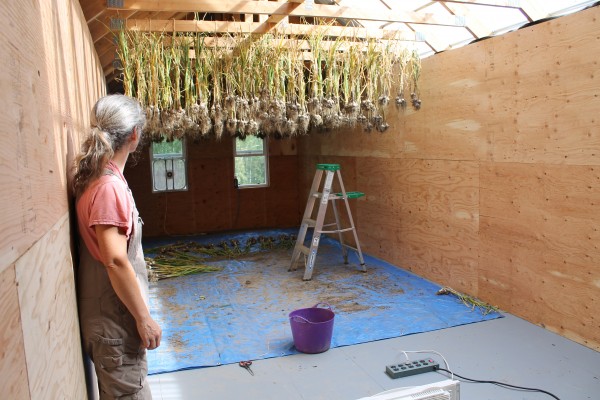Extension agent examines garlic production
September 9, 2014

Nancy Tarnai
907-474-5042
9-9-2014
How does your garlic grow?
ThatтАЩs what Tribes Extension Project Director and Educator Heidi Rader wanted to know. Rader, who works for ╨╘╙√╔ч Cooperative Extension Service and Tanana Chiefs Conference, sent a survey to growers around the state in late July.
тАЬI needed to do a short YouTube video and IтАЩve been hearing a lot about garlic,тАЭ Rader said. тАЬI donтАЩt have a lot of information.тАЭ
Due to the success of the survey, she now has many more facts and figures.
Nearly 50 people, from Southeast Alaska to Galena, completed the survey. Rader learned that garlic seems to be a relatively recent crop for Alaska. тАЬSome had been growing garlic for five to 10 years, but most had been for less than five. ItтАЩs a new trend.тАЭ
Rosie Creek Farm is one exception. тАЬI have 13 yearsтАЩ experience growing garlic commercially,тАЭ said Rosie Creek owner Mike Emers. тАЬI plant 200 pounds every year with varying success. It is labor intensive and foot by foot not very profitable. Only certain varieties are worth growing.
тАЬThere is huge demand and we use it to attract customers to buy our other crops. We will continue to grow it because of its draw for customers.тАЭ
At Calypso Farm and Ecology Center, Susan Willsrud said garlic is great for personal use. She has noticed a huge market demand. тАЬGarlic is a really fun crop because of the fall planting; itтАЩs so nice to have a crop coming up in the early spring,тАЭ Willsrud said.
тАЬIn terms of a commercial crop, the cost to grow the crop is significantly higher than what it can be sold for, particularly because the average pounds yielded to pounds planted is way less than it is in other climates. In my opinion it makes a really suitable, wonderful crop for home consumption, but a questionable one for market farming.тАЭ
Seed garlic is expensive and is often sold for a similar or sometimes lower price per pound as a final product, Willsrud said. тАЬI think most of us are really excited when it comes up and then when we get a harvest out of it,тАЭ she said. тАЬSo a farmer is likely to say something favorable because it's easy to forget how many pounds we had to buy, plant, tend, harvest and clean in order to get that crop. Overall, even with great market demand, it's a risky, low-value crop for the farmer.тАЭ
At the Alaska Botanical Garden in Anchorage, Executive Director Julianne McGuinness has been growing garlic for 15 years and has conducted many variety trials. тАЬI definitely want to offer any encouragement I can for garlic as a productive crop for Alaska farms and gardens,тАЭ she said.
Rader, who also grows garlic at her own farm, explained that there is a bounty of varieties, with two subspecies, hard-necked and soft-necked. тАЬThe hard is better for Alaska,тАЭ Rader said. тАЬThat at least is a starting point.тАЭ
Some of the popular varieties in Alaska are Music, Siberian, Chesnook Red and German White.
Garlic is planted in the fall a week or two after the first killing frost and covered with mulch. тАЬYou fertilize it a little bit and harvest it the next summer,тАЭ Rader said. тАЬItтАЩs no harder to grow than onions; itтАЩs similar, but you do it in the fall.тАЭ
Rader recommends trying a few varieties. Note the survival rate, the size and the number of cloves produced. Taste is, of course, another important factor.
тАЬNow is a good time to think about planting garlic in the Interior," Rader said. "ItтАЩs a fun thing to experiment with.тАЭ


